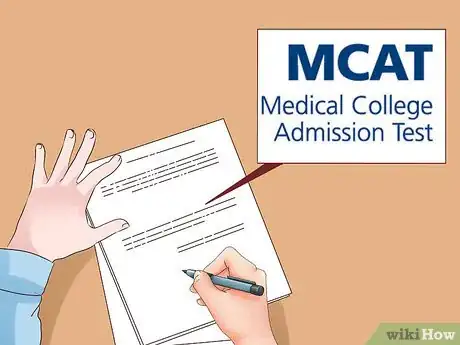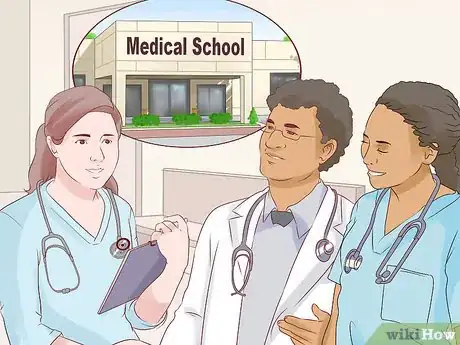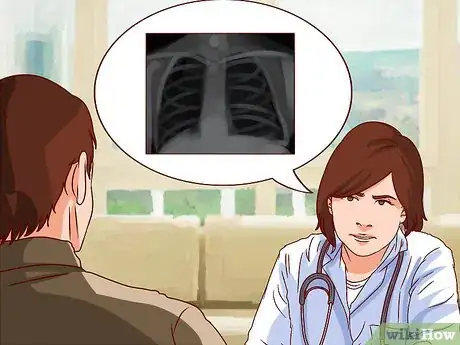This article was co-authored by wikiHow Staff. Our trained team of editors and researchers validate articles for accuracy and comprehensiveness. wikiHow's Content Management Team carefully monitors the work from our editorial staff to ensure that each article is backed by trusted research and meets our high quality standards.
There are 7 references cited in this article, which can be found at the bottom of the page.
wikiHow marks an article as reader-approved once it receives enough positive feedback. In this case, 89% of readers who voted found the article helpful, earning it our reader-approved status.
This article has been viewed 230,420 times.
Learn more...
Radiologists are medical doctors who use diagnostic machines and procedures to assess and treat patients. They do imaging tests, such as CAT scans, PET scans, MRIs, and x-rays, and read the results. Some radiologists may rarely consult directly with patients, but many interact with patients and their team of doctors. To become a radiologist, go to med school, pass all your exams, and complete your residency.
Steps
Completing the Education Requirements
-
1Take classes to prepare for your career in high school. It's never too early to start thinking of your career. If you think you would like to be a radiologist, start taking classes in high school to prepare. Science and math classes classes will help you get ahead. Take AP and upper level courses if possible. A high GPA will help you get into a good undergrad program.[1]
- Try psychology classes to help you learn about people and human nature. Humanities courses can help you with your communication skills.
- Volunteering at health clinics or nursing homes during high school can also help give you some good experience.
-
2Get a pre-med or science bachelor's degree. Since your goal is to become a radiologist, what you do as an undergrad is very important. Start working towards that goal with the classes you choose. Complete your degree in a science field, such as biology, chemistry, or pre-med.[2]
- Make sure to choose a college that is accredited. Do research to find out which schools are going to help you with your goal of med school.
- Since medical school is very competitive, focus on getting a high GPA. Earning honors, completing difficult research projects, and earning awards will help you to be accepted into med school.
Advertisement -
3Volunteer or apply for medical internships. Volunteering and internships are great ways to get hands on experience These opportunities will teach you about your career, and help give you experience that will look good on your medical school application.[3]
- For example, try volunteering at health clinics or hospitals. You may also want to look into nursing homes.
- You may also want to try applying for medical internships. Talk to your professors, advisors, or local healthcare professionals about opportunities.
-
4Attend medical school. After passing the MCAT, you will apply to medical programs. There are two different paths you can take. You can get a medical degree (MD) or doctor of osteopathic medicine (DO), which focuses on the musculoskeletal system. Med school lasts for four years.[4]
- During medical school, you will spend a couple of years completing coursework, and then you will move into doing clinicals, which is where you will get hands on experience working with health care professionals.
Passing the Needed Exams
-
1Take the Medical College Admissions Test (MCAT). The MCAT is a standardized test that is required to get into med school. It is in a multiple choice format, and is given over four and a half hours. A good score on this test will increase your likelihood of acceptance into competitive med schools.[5]
- The MCAT costs between $300 and $400. If you come from a lower income background, the Association of American Medical Colleges offers a fee assistance program that you can apply for to help with the cost of the exam.[6]
- You will be tested on various aspects of biological and biochemical concepts, along with critical analysis and problem solving.
- Most med schools require a MCAT score with your application.
-
2Pass the licensing exams. Near the end of medical school, get ready to tackle some tough exams that will set you up for graduation and your career. The scores will also help you compete for radiology residencies. The test you take will depend on whether you are getting an MD or DO.[7] [
- In the US, most radiologists take the United States Medical Licensing Exam (USMLE). The USMLE has three steps you must complete. This is also the medical licensing exam most medical doctors take.
- Some schools will instead give the Comprehensive Osteopathic Medical Licensing Exam (COMLEX). This is for radiologists who get a DO (doctor of osteopathic medicine).
-
3Apply for a license to practice medicine. Once you decide where you want to practice, you need to apply for a license. You may have to take an additional state or country-specific exam before obtaining your license.
- These exams may be written or clinical.
-
4Apply for radiology certifications. You may want to become certified by a professional radiology organization. Many radiologists take written and oral tests to be certified by a recognized professional group for additional certifications.
- For example, in the US you would take exams through the American Osteopathic Board of Radiology (AOBR) or the American Board of Radiology (ABR).
- Getting certified through a professional organization will serve as an extra credential and put you in touch with professional associates.
Starting Your Profession
-
1Start a clinical internship. After graduating from medical school, you will begin a hands-on training clinical internship. You will complete this during the first year of your residency. During this time, you will practice general medicine or surgery.[8]
-
2Complete your residency. To become a radiologist, you will complete four years in a radiology residency. This is usually done through a teaching hospital that has residencies in diagnostic radiology and radiation oncology. You will be supervised by a practicing, licensed radiologist.[9]
- You will learn about the different areas of radiology and different imaging techniques.
- You will be paid during this time.
-
3Apply for a fellowship if you want to be a specialist. You may want to apply for a fellowship after finishing your residency. Choose this path if you are interested in specializing in the imaging of a particular body part, a certain group, or a specific disease. This takes one to two years to complete.[10]
- For example, you may do a fellowship if you wanted to specialize in breast or brain imaging, or focus only on cancer. You may also do this if you want to work with children or elderly.
-
4Practice medicine as a radiologist in a clinic or hospital. Most radiologists manage a staff of technicians and other licensed professionals during their radiology career. Some open their own practices, while others join a group of doctors.[11]
- Most doctors choose to join other doctors, especially at the beginning of their career.
- You may want to open your own practice after you have been working for a few years.
- Look for jobs through professional organizations, job listings, or other professionals you've met.
References
- ↑ https://bigfuture.collegeboard.org/careers/health-diagnosis-treatment-radiologists
- ↑ http://doctorly.org/how-to-become-a-radiologist/
- ↑ https://bigfuture.collegeboard.org/careers/health-diagnosis-treatment-radiologists
- ↑ http://www.innerbody.com/careers-in-health/how-to-become-a-radiologist.html
- ↑ http://doctorly.org/how-to-become-a-radiologist/
- ↑ https://students-residents.aamc.org/applying-medical-school/article/eligibility/
- ↑ http://www.neighborhoodradiologist.com/how-to-become-a-radiologist/
- ↑ http://www.innerbody.com/careers-in-health/how-to-become-a-radiologist.html
- ↑ http://learn.org/articles/What_Are_the_Education_Requirements_to_be_a_Radiologist.html
About This Article
If you’re interested in becoming a radiologist, take math and science classes in high school, which will help prepare you for college. Enroll in upper-level courses if you can, and try to do well in all your classes, since a good GPA will help you get into a good undergrad program. Also, volunteer at a health clinic or nursing home if possible, so you can get some good experience and gauge your interest in healthcare more broadly. When it’s time to apply to college, look for an accredited school, and plan to get your bachelor’s degree in biology, chemistry, or pre-med. To learn how to take the right exams and apply to medical school once you’ve gotten your bachelor’s degree, read on!










































































